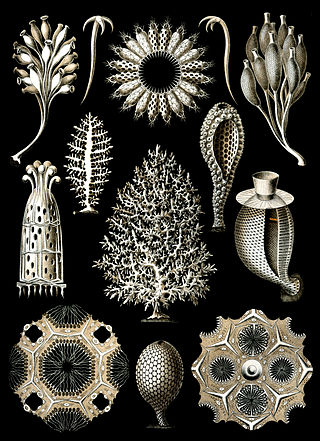
The calcareoussponges are members of the animal phylum Porifera, the cellular sponges. They are characterized by spicules made of calcium carbonate, in the form of high-magnesium calcite or aragonite. While the spicules in most species are triradiate, some species may possess two- or four-pointed spicules. Unlike other sponges, calcareans lack microscleres, tiny spicules which reinforce the flesh. In addition, their spicules develop from the outside-in, mineralizing within a hollow organic sheath.

Leucosolenida is an order of sponges in the class Calcarea and the subclass Calcaronea. Species in Leucosolenida are calcareous, with a skeleton composed exclusively of free spicules without calcified non-spicular reinforcements.

The siliceous sponges form a major group of the phylum Porifera, consisting of classes Demospongiae and Hexactinellida. They are characterized by spicules made out of silicon dioxide, unlike calcareous sponges.

Minchinellidae is a family of calcareous sponges, members of the class Calcarea. It is the only family in the monotypic order Lithonida. The families Petrobionidae and Lepidoleuconidae have also sometimes been placed within Lithonida, though more recently they have been moved to the order Baerida. Thanks to their hypercalcified structure, minchinellids have a fossil record reaching as far back as the Jurassic Period.
Baerida is an order of sea sponges in the subclass of Calcaronea, first described in 2000 by Radovan Borojevic, Nicole Boury-Esnault and Jean Vacelet. Baerida contains four families; two of these families were formerly placed within the order Lithonida.

Hexasterophora are a subclass of glass sponges in the class Hexactinellida. Most living hexasterophorans can be divided into three orders: Lyssacinosida, Lychniscosida, and Sceptrulophora. Like other glass sponges, hexasterophorans have skeletons composed of overlapping six-rayed spicules. In addition, they can be characterized by the presence of hexasters, a type of microsclere with six rays unfurling into multi-branched structures.

Borojevia cerebrum is a species of calcareous sponge from the Mediterranean Sea. The species name refers to the brain-like appearance of the sponge.

Clathrina coriacea is a species of calcareous sponge belonging to the class Calcarea and family Clathrinidae. Species in the genus Clathrina are composed of calcium carbonate tube-like skeletons containing spicules. The sponge can be located in shallow waters widely distributed along North Atlantic coasts, as well as on other coasts.
Arturia dubia is a species of calcareous sponge in the genus Arturia from Australia. The species was first described as Leucosolenia dubia by Arthur Dendy in 1891. The name is derived from Dendy's uncertainty about the validity of the species, believing his specimens could, in fact, represent juvenile Leucosolenia cavata.
Clathrina heronensis is a species of calcareous sponge fin the family Clathrinidae and found in the seas around Australia, and in the coastal seas of many islands to her north. It was first described by Gert Wörheide and John Hooper in 1999.

Spicules are structural elements found in most sponges. The meshing of many spicules serves as the sponge's skeleton and thus it provides structural support and potentially defense against predators.
Heteractinida is an extinct grade of Paleozoic (Cambrian–Permian) sponges, sometimes used as a class or order. They are most commonly considered paraphyletic with respect to Calcarea, though some studies instead argue that they are paraphyletic relative to Hexactinellida. Heteractinids can be distinguished by their six-pronged (snowflake-shaped) spicules, whose symmetry historically suggested a relationship with the triradial calcarean sponges.
Clathrina antofagastensis is a species of calcareous sponge from Chile. The species is named after Antofagasta, Chile, where the holotype was discovered.
Clathrina broenstedi is a species of calcareous sponge from the Weddell Sea. The species is named after Holger Brøndsted, a Danish sponge researcher. The only spicules present in this species are triactines.

Baeriidae is a family of calcareous sponges in the class Calcarea. It was named by Borojevic, Boury-Esnault, and Vacelet in 2000. The type genus is BaeriaMiklucho-Maclay, 1870, by original designation, though Baeria is now considered a junior synonym of LeuconiaGrant, 1833.

Amphidiscosida is an order of hexactinellids. The Amphidiscosida are commonly regarded as the only living sponges in the subclass Amphidiscophora.
Sceptrulophora is an order of hexactinellid sponges. They are characterized by sceptrules, a type of microsclere with a single straight rod terminating at a bundle of spines or knobs. An anchor- or nail-shaped sceptrule is called a clavule. A fork-shaped sceptrule, ending at a few large tines, is called a scopule. A broom-shaped sceptrule, ending at many small bristles, is called a sarule.

Stellispongiida is an order of calcareous sponges, most or all of which are extinct. Stellispongiids are one of several unrelated sponge groups described as "inozoans", a name referring to sponges with a hypermineralized calcitic skeleton independent from their spicules. Stellispongiids have a solid skeleton encasing calcite spicules arranged in trabeculae. "Inozoans" and the similar "sphinctozoans" were historically grouped together in the polyphyletic order Pharetronida.
Astraeospongium is a genus of calcareous sponge from the Silurian. Known species include A. meniscum and A. patina.










